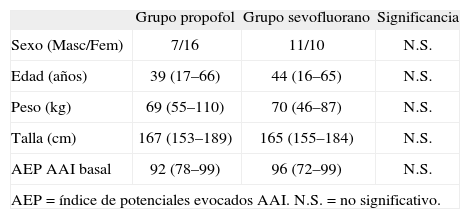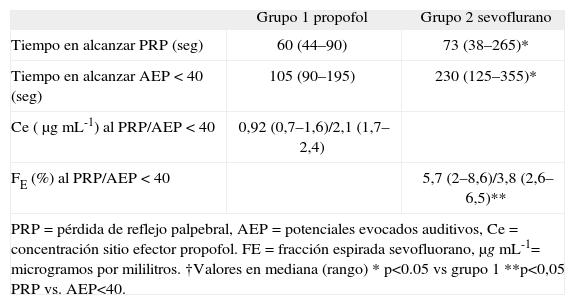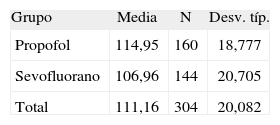Comprobar si la inducción inhalatoria sería más rápida que la intravenosa controlada por ordenador (TCI).
Material y métodosPacientes, ASA 1–2 programados para cirugía electiva, “separados en grupos GP (Propofol TCI) y GS (sevofluorano)”, todos con perfusión de remifentanilo TCI a 5ngL−1. Se realizó una inducción rápida utilizando en el GP TCI modo sitio efector 2,8μg mL−1 y en GS Sevoflurano 8%. Se midieron los tiempos de pérdida de reflejo palpebral, variables hemodinámicas, respiratorias, profundidad hipnótica con potenciales evocados auditivos (AAI) y el momento en que el anestesiólogo decide intubar. El tiempo en alcanzar un AAI menor a 40 sirvió como control del grado de hipnosis adecuado para intubar la tráquea.
ResultadosSe incluyeron 44 pacientes, el GP tardó 60 (44–90) seg en perder el reflejo palpebral (PRP), y GS tardó 72 (38–265) seg (p<0,05). Un AAI menor de 40, lo alcanzó GP en 105 (90–195) seg y GS en 230 (125–355) seg. La concentración calculada en sitio efector (Ce) tuvo una variación coherente con el sentido del cambio del valor AAI, mientras Ce subía, AAI bajaba. La fracción espirada de sevoflurano, no. En 2 casos del GS no se autorizó al anestesiólogo a intubar, al no haberse alcanzado el AAI exigido. Los pacientes inducidos de GS tuvieron un descenso de la presión arterial significativamente mayor que los GP.
ConclusiónLa inducción propofol TCI sitio efector es más rápida que con sevofluorano. La Ce de propofol se comporta coherentemente con el sentido del cambio del monitor AAI.
To determine whether inhalation induction is faster than target-controlled infusion (TCI).
Material and methodsPatients in ASA physical status 1 or 2 who were scheduled for elective surgery were randomized to a propofol TCI group or a sevoflurane group. Both groups received a TCI of 5 ng·L−1 of remifentanil. Rapid induction was performed using an effect-site TCI of 2.8 μg·mL−1 of propofol in the propofol group and 8% sevoflurane in the sevoflurane group. We recorded time until loss of the palpebral reflex, hemodynamic variables, respiratory variables, hypnotic depth of anesthesia using the auditory evoked potentials index (AAI), and the moment the anesthesiologist decided to intubate. Also recorded was the time taken to reach an AAI of less than 40, which was established as the threshold of hypnotic depth sufficient for tracheal intubation.
ResultsForty-four patients were enrolled in the trial. The palpebral reflex loss time was 60 (44–90) seconds in the TCI-propofol group and 72 (38–265) seconds in the sevoflurane group (P<.05). An AAI of less than 40 was reached in 105 (90–195) seconds in the TCI-propofol group and in 230 (125–355) seconds in the sevoflurane group. The variation in the calculated effect-site concentration (Ce) was consistent with the direction of change in the AAI value, which decreased as Ce increased; the variation in the expired fraction of sevoflurane did not show the same relationship. The anesthesiologist was not authorized to intubate 2 patients in the sevoflurane group as the AAI threshold was not reached. The decrease in blood pressure was significantly greater in patients in the sevoflurane group than in those in the propofol group.
ConclusionAnesthetic induction is faster with a TCI of propofol based on Ce than with sevoflurane. The propofol Ce was consistent with the direction of change in the AAI.
Artículo
Comprando el artículo el PDF del mismo podrá ser descargado
Precio 19,34 €
Comprar ahora












